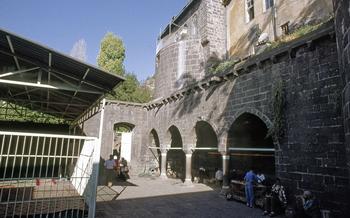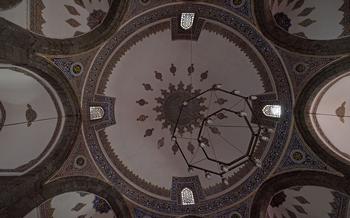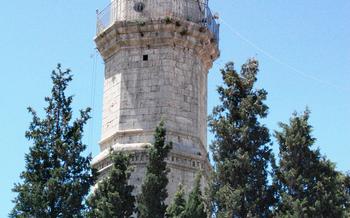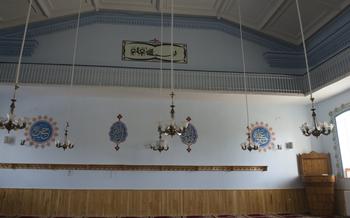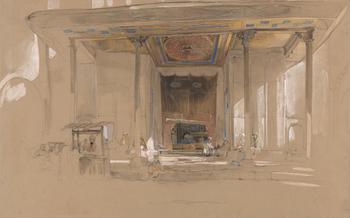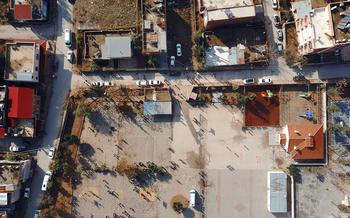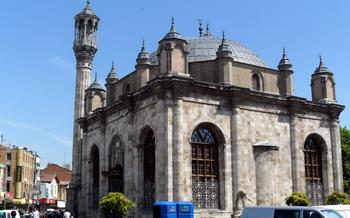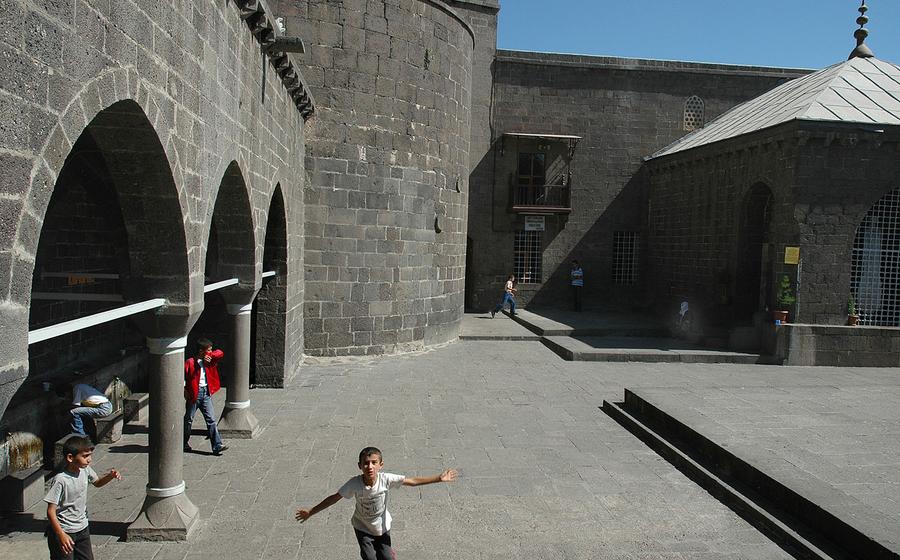
Hazreti Süleyman Mosque
- History of the Hazreti Süleyman Mosque
- The Architecture of the Hazreti Süleyman Mosque
- The Hazreti Süleyman Mosque as a Tourist Destination
- Visiting the Hazreti Süleyman Mosque: A Step-by-Step Guide
- Tips for Taking Photos of the Hazreti Süleyman Mosque
- The Hazreti Süleyman Mosque in Popular Culture
- The Hazreti Süleyman Mosque and the Environment
- The Hazreti Süleyman Mosque in Literature
- The Hazreti Süleyman Mosque in Art
- Insider Tip: The Best Time to Visit the Hazreti Süleyman Mosque
History of the Hazreti Süleyman Mosque
The Hazreti Süleyman Mosque, an architectural gem nestled in the heart of Diyarbakır, Turkey, holds a significant place in the city's historical and religious landscape. Its construction dates back to the Artuqid period, a time marked by architectural innovation and cultural flourishing. The mosque, named after Prophet Solomon, is believed to have been built in the 12th century, during the reign of Artuqid ruler Fahrettin Karaaslan. While the exact architect remains unknown, the mosque's architectural style reflects a blend of Seljuk and Byzantine influences, a testament to the region's rich cultural heritage. Over the centuries, the mosque has undergone several renovations and additions, each contributing to its unique architectural evolution. It has withstood the test of time, becoming an enduring symbol of Diyarbakır's Islamic heritage.
- Keywords: Artuqid period, Fahrettin Karaaslan, Seljuk, Byzantine, architectural evolution.
The Architecture of the Hazreti Süleyman Mosque
The Hazreti Süleyman Mosque, with its imposing structure and captivating design, stands as a testament to the architectural brilliance of the Islamic world. Built in the 12th century, this magnificent mosque showcases a unique blend of Seljuk and Ottoman architectural styles, resulting in a breathtaking masterpiece.
The mosque's vast courtyard, measuring approximately 100 meters in length and 70 meters in width, provides a serene and awe-inspiring space for prayer and contemplation. The courtyard is surrounded by a series of vaulted arcades supported by elegant columns, creating a sense of grandeur and symmetry.
Constructed using local stone and brick, the mosque boasts a sturdy and durable structure that has withstood the test of time. Its exterior walls are adorned with intricate carvings and decorative motifs, showcasing the exceptional craftsmanship of the period.
One of the most striking features of the Hazreti Süleyman Mosque is its towering dome, which dominates the skyline of Diyarbakır. The dome, measuring 20 meters in diameter, is supported by a system of squinches and pendentives, demonstrating the mosque's innovative architectural techniques.
The interior of the mosque is equally impressive, adorned with intricate tilework, vibrant frescoes, and ornate calligraphy. The mihrab, or prayer niche, is a masterpiece of Islamic art, featuring intricate geometric patterns and colorful tiles that create a mesmerizing focal point.
The Hazreti Süleyman Mosque stands out from other Islamic buildings due to its unique features and design elements. Its massive courtyard, towering dome, and exquisite ornamentation set it apart as a remarkable example of Seljuk and Ottoman architecture.
The Hazreti Süleyman Mosque as a Tourist Destination
**Why visit is a must-see destination for anyone visiting Diyarbakır. Its stunning architecture, rich history, and religious significance make it one of the most important landmarks in the city. Visitors can admire the mosque's intricate carvings, colorful tiles, and soaring minarets. They can also learn about the mosque's history and role in the city's religious life.
Best time to visit the Hazreti Süleyman Mosque
The best time to visit the Hazreti Süleyman Mosque is during the shoulder seasons (spring and fall)
Visiting the Hazreti Süleyman Mosque: A Step-by-Step Guide
How to get to the mosque: The Hazreti Süleyman Mosque is located in the heart of Diyarbakır, Turkey. It is easily accessible by public transportation or taxi. If you are driving, there are several parking lots nearby.
What to expect when you arrive: When you arrive at the mosque, you will be greeted by a friendly and welcoming staff. They will provide you with information about the mosque and its history. You will also be given a headscarf or headscarf to wear while you are inside the mosque.
The different parts of the mosque that visitors can explore: The mosque is open to visitors during certain hours of the day. Visitors can explore the mosque's courtyard, prayer hall, and minarets. The courtyard is a beautiful space with a fountain and a garden. The prayer hall is the most important part of the mosque, where Muslims pray five times a day. The minarets are tall towers that are used to call Muslims to prayer.
The best way to experience the mosque's atmosphere: The best way to experience the mosque's atmosphere is to visit during a prayer service. You can sit in the back of the prayer hall and observe the Muslims as they pray. You can also listen to the beautiful recitation of the Quran.
Tips for Taking Photos of the Hazreti Süleyman Mosque
The Hazreti Süleyman Mosque offers many stunning photo opportunities, both inside and out. Here are some tips for taking the best possible photos of this iconic landmark:
-
Choose the Right Angle: The mosque's imposing size and intricate details can be challenging to capture in a single shot. Try experimenting with different angles and perspectives to find the one that best showcases the mosque's grandeur.
-
Consider the Lighting: The lighting at the mosque can dramatically impact the mood and atmosphere of your photos. Visit at different times of the day to capture the mosque in different light conditions.
-
Use Filters and Editing Software: Filters and editing software can help you enhance the colors and contrast of your photos, making them more vibrant and visually appealing.
-
Be Respectful: Remember that the mosque is a place of worship, so be mindful of the worshippers and their privacy. Avoid taking photos that could be disruptive or disrespectful.
The Hazreti Süleyman Mosque in Popular Culture
The Hazreti Süleyman Mosque, with its striking architecture and historical significance, has been featured in various forms of popular culture. It has made appearances in movies, TV shows, and literature, serving as a backdrop for stories and adding authenticity to historical narratives.
In the Turkish film "Diyarbakır'ın Surları İçinde" (Within the Walls of Diyarbakır), the mosque plays a central role as a symbol of the city's rich cultural heritage. The film captures the mosque's architectural grandeur and its importance to the local community.
The mosque has also been featured in several Turkish TV shows, including the historical drama "Diriliş: Ertuğrul," which depicts the early days of the Ottoman Empire. The mosque is shown as a place of worship and a gathering place for the Muslim community during the Seljuk era.
In literature, the Hazreti Süleyman Mosque has been immortalized in the works of renowned Turkish writers. The mosque appears in the novel "The Forty Rules of Love" by Elif Shafak, where it serves as a setting for a pivotal conversation between the protagonist and a wise Sufi master. The mosque's spiritual atmosphere and architectural beauty contribute to the novel's mystical and philosophical themes.
These depictions in popular culture showcase the Hazreti Süleyman Mosque's enduring legacy and its deep connection to the cultural identity of Diyarbakır. The mosque's presence in movies, TV shows, and literature highlights its significance as a symbol of faith, history, and cultural heritage.
The Hazreti Süleyman Mosque and the Environment
The Hazreti Süleyman Mosque is committed to reducing its environmental impact. In recent years, the mosque has implemented several initiatives to become more sustainable. These initiatives include:
- Using renewable energy sources: The mosque has installed solar panels on its roof to generate electricity. The mosque also uses geothermal energy to heat and cool the building.
- Reducing water consumption: The mosque has installed low-flow faucets and toilets to reduce water usage. The mosque also has a rainwater harvesting system to collect and reuse rainwater.
- Recycling and composting: The mosque recycles paper, plastic, and metal. The mosque also composts food waste to create fertilizer for the mosque's gardens.
- Promoting environmental awareness: The mosque holds educational programs to teach the community about environmental issues. The mosque also participates in local environmental cleanup events.
The Hazreti Süleyman Mosque's commitment to sustainability is a model for other religious institutions. The mosque's efforts to reduce its environmental impact show that it is possible to be a good steward of the environment while still maintaining a vibrant religious community.
The Hazreti Süleyman Mosque in Literature
The Hazreti Süleyman Mosque, with its rich history and captivating architecture, has been immortalized in the words of countless literary works. From poetry to novels and short stories, the mosque has served as a backdrop for fictional events and a symbol of faith and resilience.
In the novel "Diyarbakır'ın Sırları" by local author Mehmet Akif Ersoy, the mosque plays a central role in the story of a young woman who discovers the hidden secrets of her city. As she explores the mosque's hidden corners, she uncovers a conspiracy that threatens the city's future.
In the short story "The Muezzin's Call" by renowned Turkish writer Yaşar Kemal, the mosque's muezzin, with his haunting voice, becomes a symbol of hope and defiance in the face of adversity. His call to prayer echoes through the city's streets, reminding people of their faith and encouraging them to stand united against oppression.
The mosque's unique architecture and spiritual significance have also inspired poets from all over the world. In the poem "Diyarbakır'ın Güzelliği" by local poet Ayşe Kulin, the mosque's minarets are described as "reaching towards the heavens, like prayers ascending to God." The poem captures the mosque's beauty and its ability to inspire awe and wonder in those who behold it.
Through literature, the Hazreti Süleyman Mosque has become an integral part of Diyarbakır's cultural identity. It represents the city's rich history, its spiritual essence, and its enduring spirit.
The Hazreti Süleyman Mosque in Art
The Hazreti Süleyman Mosque, with its stunning architecture and captivating history, has been an endless source of inspiration for artists throughout the ages. Its unique features and intricate details have been captured in a variety of artworks, ranging from paintings and sculptures to mosaics and miniatures.
One of the most famous depictions of the mosque is the painting "The Hazreti Süleyman Mosque at Sunset" by the renowned Turkish artist Osman Hamdi Bey. In this breathtaking canvas, the mosque's majestic silhouette is bathed in the warm glow of the setting sun, casting long shadows across the surrounding landscape. The painting masterfully captures the mosque's grandeur and serenity, inviting viewers to contemplate its timeless beauty.
Another notable artwork inspired by the mosque is the sculpture "The Muezzin" by the contemporary artist Mehmet Aksoy. This bronze sculpture portrays a muezzin, or Islamic call to prayer, standing atop one of the mosque's minarets. The muezzin's outstretched arms and serene expression evoke a sense of spirituality and devotion, highlighting the mosque's role as a center of religious worship.
The Hazreti Süleyman Mosque has also been immortalized in intricate mosaics and miniatures. These delicate artworks often depict scenes from the mosque's history or showcase its architectural details with remarkable precision. They serve as a testament to the skill and artistry of the craftsmen who created them, and offer a glimpse into the mosque's rich cultural heritage.
Whether through paintings, sculptures, or other forms of art, the Hazreti Süleyman Mosque continues to captivate the imaginations of artists and inspire new creations. These artworks not only document the mosque's architectural beauty but also convey its spiritual significance and cultural importance, ensuring that its legacy lives on for generations to come.
Insider Tip: The Best Time to Visit the Hazreti Süleyman Mosque
The best time to visit the Hazreti Süleyman Mosque is early in the morning or late in the afternoon, when the crowds are smaller and the temperature is more pleasant. This will give you plenty of time to explore the mosque's interior and exterior without feeling rushed. If you are interested in attending a prayer service, be sure to check the mosque's website or call ahead for the schedule.
During the summer months, the mosque is open from 9:00 am to 7:00 pm. In the winter months, the hours are shorter, from 9:00 am to 5:00 pm. The mosque is closed on Fridays for congregational prayers.
If you are visiting the mosque during Ramadan, be aware that the hours may be different. It is also important to be respectful of the religious practices of the Muslim community during this time.
Special events and activities are often held at the mosque, such as lectures, workshops, and exhibitions. These events are a great way to learn more about the mosque and its history. Be sure to check the mosque's website or social media pages for more information.
The Hazreti Süleyman Mosque is a beautiful and historic building that is well worth a visit. By following these tips, you can make the most of your experience.

